The Cranial Navigation Systems Market is estimated to be valued at USD 2.8 billion in 2025 and is projected to reach USD 3.8 billion by 2035, registering a compound annual growth rate (CAGR) of 3.1% over the forecast period.
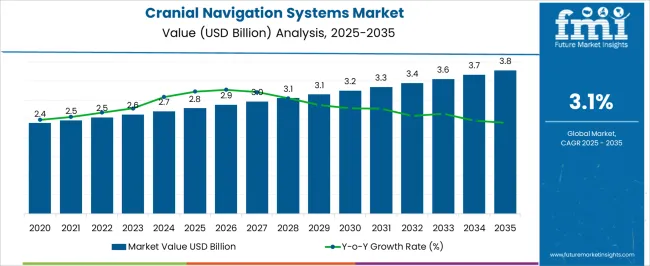
| Metric | Value |
|---|---|
| Cranial Navigation Systems Market Estimated Value in (2025 E) | USD 2.8 billion |
| Cranial Navigation Systems Market Forecast Value in (2035 F) | USD 3.8 billion |
| Forecast CAGR (2025 to 2035) | 3.1% |
The Cranial Navigation Systems market is experiencing steady growth driven by the increasing demand for precision and minimally invasive neurosurgical procedures. The current market landscape is shaped by the adoption of advanced navigation technologies that enhance surgical accuracy, reduce operative risks, and improve patient outcomes.
Hospitals and surgical centers are increasingly prioritizing systems that integrate real-time imaging with intelligent navigation, enabling complex procedures such as tumor resections and deep brain stimulations to be performed with enhanced safety. Investments in healthcare infrastructure, rising neurosurgical procedure volumes, and growing awareness among surgeons regarding the benefits of navigation-assisted surgery are further supporting market expansion.
Additionally, technological advancements such as high-definition imaging, real-time software updates, and integration with robotic-assisted platforms are expected to drive future adoption As the global burden of neurological disorders continues to rise, cranial navigation systems are poised to remain critical tools in modern neurosurgery, offering long-term growth potential across both developed and emerging markets.
The cranial navigation systems market is segmented by product type, end user, and geographic regions. By product type, cranial navigation systems market is divided into Optical System and Electromagnetic System. In terms of end user, cranial navigation systems market is classified into Hospital, Specialty Clinics, and Others. Regionally, the cranial navigation systems industry is classified into North America, Latin America, Western Europe, Eastern Europe, Balkan & Baltic Countries, Russia & Belarus, Central Asia, East Asia, South Asia & Pacific, and the Middle East & Africa.
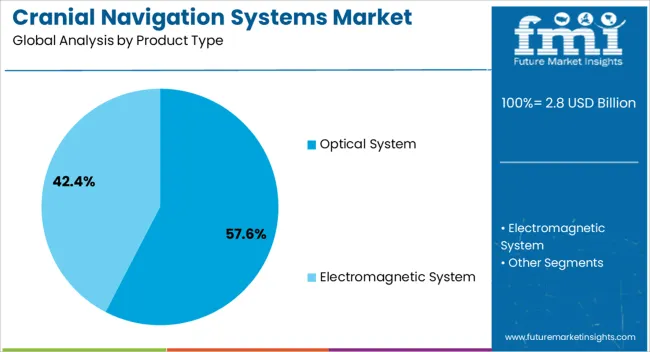
The Optical System product type is projected to account for 57.60% of the Cranial Navigation Systems market revenue in 2025, making it the leading product type. This dominance is being driven by its high accuracy, reliability, and real-time feedback capabilities, which are essential for delicate cranial procedures.
Optical systems are widely adopted because they provide precise tracking of surgical instruments relative to patient anatomy, significantly reducing the risk of errors during complex operations. The growth of this segment has been reinforced by the integration of advanced imaging sensors and improved calibration techniques, which enhance system performance without requiring extensive hardware modifications.
Furthermore, the ease of integration with existing hospital infrastructure and compatibility with multiple surgical platforms have accelerated adoption The ability to deliver consistent results, even in high-volume surgical settings, has made optical systems the preferred choice for neurosurgeons, ensuring sustained leadership in the product type segment.
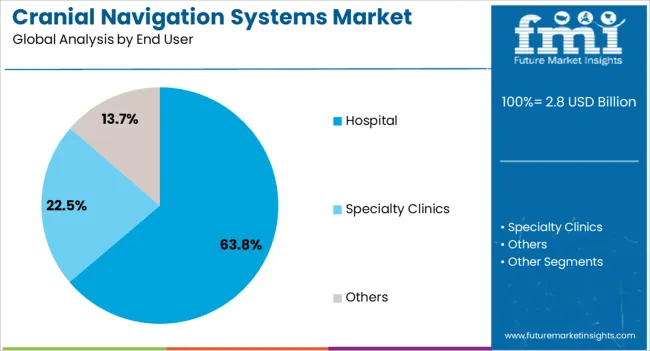
The Hospital end user segment is expected to hold 63.80% of the Cranial Navigation Systems market revenue in 2025, positioning it as the largest consumer among end users. This leadership is being driven by the increasing number of neurosurgical procedures performed in hospital settings and the prioritization of patient safety and surgical precision.
Hospitals are investing heavily in navigation systems that enhance operative efficiency, reduce procedure times, and minimize postoperative complications. The ability to deploy these systems across multiple surgical suites and train staff on software updates without hardware replacements has contributed to their rapid adoption.
Additionally, hospitals benefit from improved resource utilization and better surgical outcomes, which directly impact operational costs and patient satisfaction The rising focus on advanced medical technologies, coupled with the increasing prevalence of neurological disorders and the expansion of hospital networks, is expected to further strengthen demand for cranial navigation systems in the hospital segment, ensuring sustained market growth.
Cranial navigation is commonly performed by registration with optic tracking, fiducial markers and intermittent pointer-based application. Cranial navigation system provides patient specific, three dimensional anatomy for navigation in preoperative and intraoperative which help surgeons to perform complicated procedures with improved accuracy and safety.
The primary principle of navigation system is the localizing technology. Cranial navigation system is a devices which is used to determine the spatial position of tracked instrument during the time of intervention. Cranial navigation systems has emerged as one of the most reliable technology as it transforms surgical interventions into less and safer invasive procedures. Cranial navigation systems helps the surgeons in the procedures, by keeping skull opening small and minimize damage.
Cranial navigation systems in neurosurgery has expanded rapidly owing to high demand of navigation systems which are accurate and safe during surgery. Cranial navigation systems are developed foe image guided neurosurgery to aid accurate resection of brain tumours. Cranial navigation system is helpful in designing the craniotomy flat or burr hole, navigation and access and extent of resection or accuracy of procedure and biopsy.
Cranial navigation systems is projected to witness significant growth in the forecast period owing to increasing number of geriatric population. Rise in adoption of cranial navigation systems as it help is safe and accurate procedure during the time of surgery drive the market of cranial navigation systems in near future.
Rising awareness regarding the minimally invasive surgical procedure for the brain spur the market of cranial navigation systems. Advancement in the technology for neurosurgical procedures drive the market for cranial navigation systems in forecast period. Brain shift deformation of brain during the surgery, intraoperative position of patient and loss of cerebrospinal fluid which gives no accurate result of preoperative image hinder the growth of cranial navigation systems.
Cranial navigation systems market is expected to grow at significant rate due to increasing need of the systems which are accurate and safe during neuro surgery. Shortened hospitals stay and shorter recovery time after the surgery will drive the cranial navigation system market. On the basis of product type, electromagnetic system accounts for the significant growth owing to increasing demand worldwide. On the basis of end user hospital segment accounts for the highest revenue share owing to increasing number of neurosurgery in the hospitals.
On the basis of geography, the global cranial navigation systems market is segmented into seven key regions: North America, Latin America, Western Europe, Eastern Europe, Asia Pacific excluding Japan, Japan, and Middle East & Africa.
North America is projected to hold the largest share of the global cranial navigation systems market owing to well established healthcare infrastructure, presence of major players and increased adoption of technologically advanced techniques. Western Europe accounts for the second-largest share owing to continuous research activities in the medical field in the neurosurgical systems, high spending capacity of people.
The Asia Pacific region is expected to be the fastest-growing region owing to an increase in healthcare expenditure, improving healthcare facilities in the public as well as private sector and growing medical tourism leads to the growth of cranial navigation systems market over the region. Lack of awareness and healthcare facilities in most parts of Middle East and Africa region leads to their least contribution in the overall global market for cranial navigation systems.
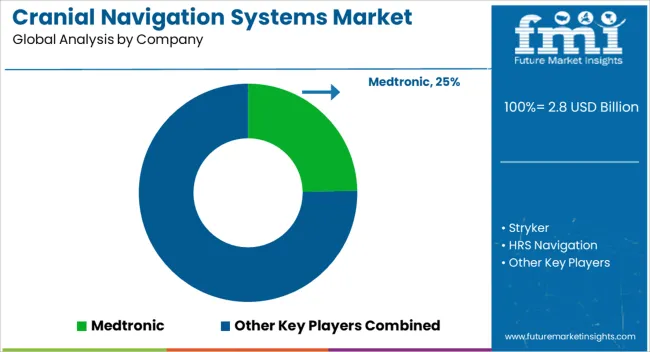
Some of the key players present in the global cranial navigation systems market are Medtronic plc, Stryker, Brainlab AG, GE Healthcare, Micromar Ind., SONOWAND AS, Fiagon GmbH among others.
The report is a compilation of first-hand information, qualitative and quantitative assessment by industry analysts, inputs from industry experts and industry participants across the value chain. The report provides in-depth analysis of parent market trends, macroeconomic indicators and governing factors along with market attractiveness as per segments. The report also maps the qualitative impact of various market factors on market segments and geographies.
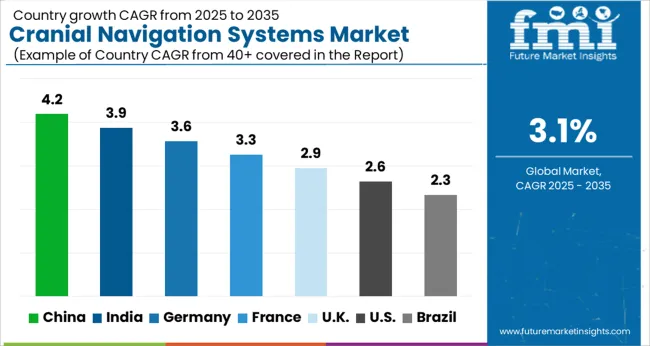
| Country | CAGR |
|---|---|
| China | 4.2% |
| India | 3.9% |
| Germany | 3.6% |
| France | 3.3% |
| UK | 2.9% |
| USA | 2.6% |
| Brazil | 2.3% |
The Cranial Navigation Systems Market is expected to register a CAGR of 3.1% during the forecast period, exhibiting varied country level momentum. China leads with the highest CAGR of 4.2%, followed by India at 3.9%. Developed markets such as Germany, France, and the UK continue to expand steadily, while the USA is likely to grow at consistent rates. Brazil posts the lowest CAGR at 2.3%, yet still underscores a broadly positive trajectory for the global Cranial Navigation Systems Market. In 2024, Germany held a dominant revenue in the Western Europe market and is expected to grow with a CAGR of 3.6%. The USA Cranial Navigation Systems Market is estimated to be valued at USD 996.8 million in 2025 and is anticipated to reach a valuation of USD 1.3 billion by 2035. Sales are projected to rise at a CAGR of 2.6% over the forecast period between 2025 and 2035. While Japan and South Korea markets are estimated to be valued at USD 151.8 million and USD 95.6 million respectively in 2025.
| Item | Value |
|---|---|
| Quantitative Units | USD 2.8 Billion |
| Product Type | Optical System and Electromagnetic System |
| End User | Hospital, Specialty Clinics, and Others |
| Regions Covered | North America, Europe, Asia-Pacific, Latin America, Middle East & Africa |
| Country Covered | United States, Canada, Germany, France, United Kingdom, China, Japan, India, Brazil, South Africa |
| Key Companies Profiled | Medtronic, Stryker, HRS Navigation, Brainlab AG, 7D Surgical, ClaroNav, Heal Force Bio-Meditech Holdings (Heal Force), Zeta Surgical Inc., Parsis Co., and Nexstim PLC |
The global cranial navigation systems market is estimated to be valued at USD 2.8 billion in 2025.
The market size for the cranial navigation systems market is projected to reach USD 3.8 billion by 2035.
The cranial navigation systems market is expected to grow at a 3.1% CAGR between 2025 and 2035.
The key product types in cranial navigation systems market are optical system and electromagnetic system.
In terms of end user, hospital segment to command 63.8% share in the cranial navigation systems market in 2025.






Our Research Products

The "Full Research Suite" delivers actionable market intel, deep dives on markets or technologies, so clients act faster, cut risk, and unlock growth.

The Leaderboard benchmarks and ranks top vendors, classifying them as Established Leaders, Leading Challengers, or Disruptors & Challengers.

Locates where complements amplify value and substitutes erode it, forecasting net impact by horizon

We deliver granular, decision-grade intel: market sizing, 5-year forecasts, pricing, adoption, usage, revenue, and operational KPIs—plus competitor tracking, regulation, and value chains—across 60 countries broadly.

Spot the shifts before they hit your P&L. We track inflection points, adoption curves, pricing moves, and ecosystem plays to show where demand is heading, why it is changing, and what to do next across high-growth markets and disruptive tech

Real-time reads of user behavior. We track shifting priorities, perceptions of today’s and next-gen services, and provider experience, then pace how fast tech moves from trial to adoption, blending buyer, consumer, and channel inputs with social signals (#WhySwitch, #UX).

Partner with our analyst team to build a custom report designed around your business priorities. From analysing market trends to assessing competitors or crafting bespoke datasets, we tailor insights to your needs.
Supplier Intelligence
Discovery & Profiling
Capacity & Footprint
Performance & Risk
Compliance & Governance
Commercial Readiness
Who Supplies Whom
Scorecards & Shortlists
Playbooks & Docs
Category Intelligence
Definition & Scope
Demand & Use Cases
Cost Drivers
Market Structure
Supply Chain Map
Trade & Policy
Operating Norms
Deliverables
Buyer Intelligence
Account Basics
Spend & Scope
Procurement Model
Vendor Requirements
Terms & Policies
Entry Strategy
Pain Points & Triggers
Outputs
Pricing Analysis
Benchmarks
Trends
Should-Cost
Indexation
Landed Cost
Commercial Terms
Deliverables
Brand Analysis
Positioning & Value Prop
Share & Presence
Customer Evidence
Go-to-Market
Digital & Reputation
Compliance & Trust
KPIs & Gaps
Outputs
Full Research Suite comprises of:
Market outlook & trends analysis
Interviews & case studies
Strategic recommendations
Vendor profiles & capabilities analysis
5-year forecasts
8 regions and 60+ country-level data splits
Market segment data splits
12 months of continuous data updates
DELIVERED AS:
PDF EXCEL ONLINE
Neuronavigation Systems Market Analysis - Size and Share Forecast Outlook 2025 to 2035
Military Navigation Systems Market
Orthopedic Navigation Systems Market Analysis – Trends, Growth & Forecast 2025 to 2035
Automotive Personal Navigation Systems Market Size and Share Forecast Outlook 2025 to 2035
Navigation SDK for Automotive Market Size and Share Forecast Outlook 2025 to 2035
Cranial Closure And Fixation Devices Market Size and Share Forecast Outlook 2025 to 2035
Navigation Switches Market Size and Share Forecast Outlook 2025 to 2035
Navigation satellite system Market Size and Share Forecast Outlook 2025 to 2035
Systems Administration Management Tools Market Size and Share Forecast Outlook 2025 to 2035
Navigation, Imaging and Positioning Solutions Market - Trends & Forecast 2025 to 2035
Cranial Stabilisation Devices Market Outlook – Share, Growth & Forecast 2025 to 2035
Cranial Clamps Market
Cranial Doppler Market
Cranial And Facial Implants Market
VRF Systems Market Growth - Trends & Forecast 2025 to 2035
Intracranial Aneurysm Market Size and Share Forecast Outlook 2025 to 2035
Transcranial Doppler Ultrasounds System Market Size and Share Forecast Outlook 2025 to 2035
Transcranial Doppler Devices Market
Cloud Systems Management Software Market Size and Share Forecast Outlook 2025 to 2035
Hi-Fi Systems Market Size and Share Forecast Outlook 2025 to 2035

Thank you!
You will receive an email from our Business Development Manager. Please be sure to check your SPAM/JUNK folder too.
Chat With
MaRIA